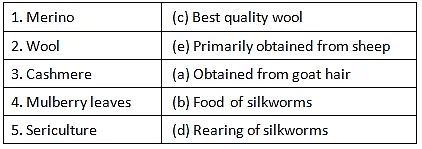Class 7 Exam > Class 7 Notes > Class 7 Oxford Science: Chapter Notes, Worksheets & Tests > Textbook Solution: Fiber to Fabric
Textbook Solution: Fiber to Fabric | Class 7 Oxford Science: Chapter Notes, Worksheets & Tests PDF Download
A. Choose the correct option.
1.
Ans: (c) Cow
2.
Ans: (c) Bactrian
3.
Ans: (a) spring
4.
Ans: (b) caterpillars
5.
Ans: (a) anthrax
B. Fill in the blanks with the correct words.
1.
Ans: Mohair wool is obtained from the Angora goat.
2.
Ans: The process of sorting and grouping wool is called grading.
3.
Ans: The wool is packed into bales and sent to the mills
4.
Ans: The four stages in the life cycle of a silk moth are egg, larva, pupa and adult.
5.
Ans: Different kinds of silk moths give us different varieties of silk.
6.
Ans: Tussar, Mooga, and Kosa are three varieties of silk.
C.
1.
Ans:

D. Name the following
1.
Ans: Fabric
2.
Ans: Wool
3.
Ans: Shearing
4.
Ans: Pupa
5.
Ans: Sericulture
E. Answer the following questions.
1.
Ans: Four breeds of animals that give good quality wool are sheep, goat, rabbit, and camel. Wool from sheep is soft and of high quality. Wool from goat, particularly Cashmere and Angora goats, is also of high quality. Wool from rabbit, particularly Angora rabbit, is very fine and expensive. Camel wool, especially from the Bactrian camel, is soft and fine.
2.
Ans: The coat of animals helps it to stay warm by trapping air in between its spaces, thus providing insulation.
3.
Ans: Mohair wool is obtained from the Angora goat. It is light, durable, and warm and is widely used to make sweaters and soft furniture coverings. Cashmere wool is a fine quality wool obtained from the Cashmere goat, it is luxuriously soft and provides great warmth.
4.
Ans: Wool production involves shearing, scouring, grading, dyeing, drying, and making the wool into fabric. Shearing is the process of removing hair or fur from animals. Scouring is the process of washing the wool to remove dirt, dust, and grease. Grading is the process of sorting and grouping wool according to its quality. Dyeing is the process of colouring the wool. Drying is the process of removing extra water from the wool after it has been washed and dyed. The wool is then made into fabric at the mills.
5.
Ans: Shearing is beneficial to sheep as it removes the fur that makes them feel hot in the summer.
6.
Ans: Diagram of the life cycle of a silk worm: egg, larva, pupa, adult moth. [Student is expected to draw the diagram]
7.
Ans: Sericulture is the rearing of silkworms for the commercial production of silk. The process of silk production involves selecting healthy silk moths for breeding, feeding the larvae with mulberry leaves, allowing the larvae to spin cocoons, and then harvesting the cocoons. The cocoons are put in boiling water to kill the caterpillar inside and loosen the silk fibre. The fibres are then pulled from the cocoons, twisted together to make a strong thread, and woven into fabric.
8.
Ans: Health hazards faced by workers in sericulture include infections from handling dead worms, blisters and wounds from dipping hands into hot water, backaches and spine problems from standing for long hours, eye strain, and respiratory infections from poor air circulation and fumes of boiling cocoons.
The document Textbook Solution: Fiber to Fabric | Class 7 Oxford Science: Chapter Notes, Worksheets & Tests is a part of the Class 7 Course Class 7 Oxford Science: Chapter Notes, Worksheets & Tests.
All you need of Class 7 at this link: Class 7
|
138 videos|151 docs|18 tests
|
FAQs on Textbook Solution: Fiber to Fabric - Class 7 Oxford Science: Chapter Notes, Worksheets & Tests
| 1. How is fabric made from fiber? |  |
Ans. Fabric is made from fiber through a process called spinning, where fibers are twisted together to form yarn. This yarn is then woven or knitted to create fabric.
| 2. What are the different types of fibers used to make fabric? |  |
Ans. There are two main types of fibers used to make fabric: natural fibers, which come from plants or animals, and synthetic fibers, which are man-made from chemicals.
| 3. How does the quality of fiber affect the fabric produced? |  |
Ans. The quality of fiber used in fabric production can greatly impact the final product. High-quality fibers result in a more durable and comfortable fabric, while low-quality fibers may lead to weaker and less comfortable fabric.
| 4. What are some common natural fibers used in fabric production? |  |
Ans. Some common natural fibers used in fabric production include cotton, wool, silk, and linen. These fibers are known for their breathability, comfort, and sustainability.
| 5. What is the role of weaving and knitting in fabric production? |  |
Ans. Weaving and knitting are two techniques used to turn yarn into fabric. Weaving involves interlacing yarn threads at right angles, while knitting involves interlocking loops of yarn. Both techniques create different types of fabric with unique textures and properties.
Related Searches
















